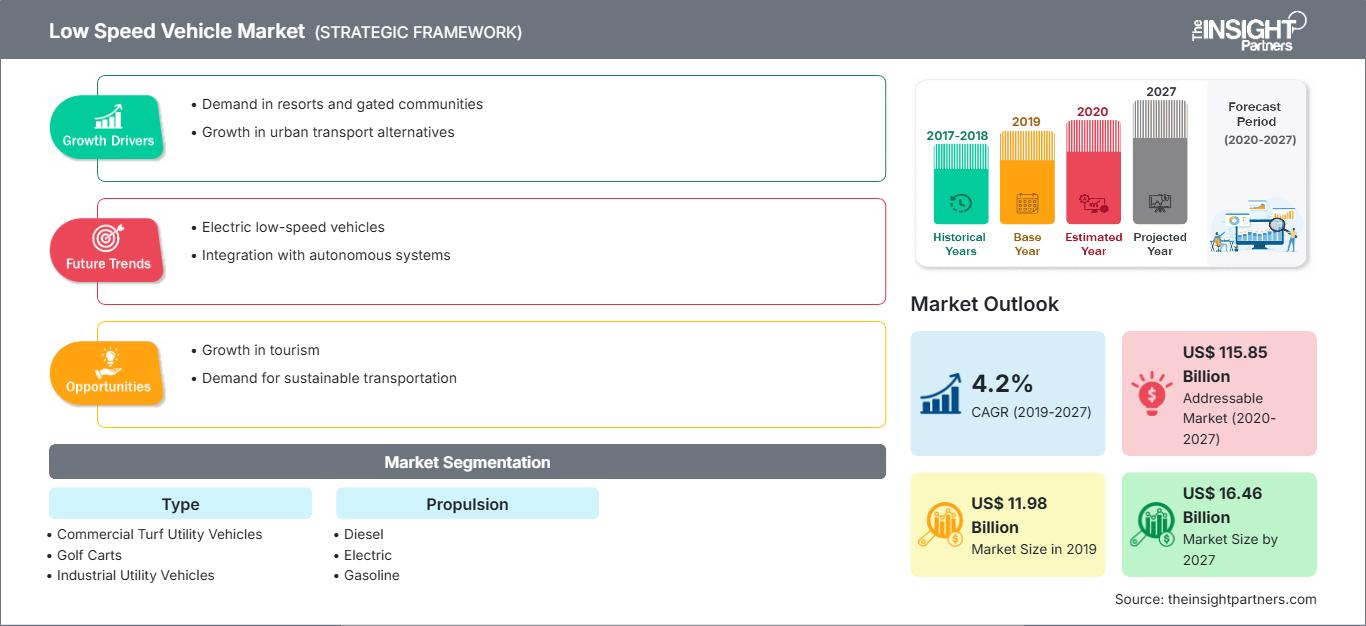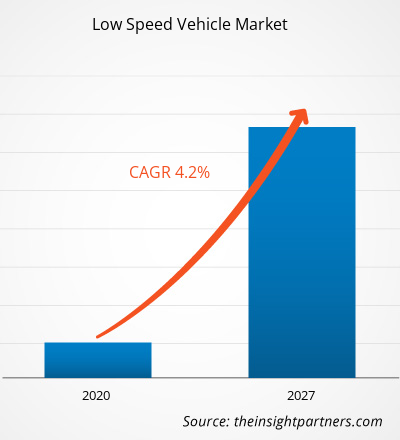Il mercato dei veicoli a bassa velocità è stato valutato a 11,98 miliardi di dollari nel 2019 e si prevede che crescerà a un CAGR del 4,2% dal 2020 al 2027, raggiungendo i 16,46 miliardi di dollari entro il 2027.
Il mercato dei veicoli a bassa velocità ha registrato una crescita significativa negli ultimi due anni a livello globale. Le prospettive economiche positive, l'aumento del reddito disponibile e la crescita demografica sono tra i fattori che stanno trainando la domanda di progetti infrastrutturali. Inoltre, in relazione all'elevato volume di ordini online, il settore dell'e-commerce è in crescita, il che si tradurrà in un aumento della proprietà dei magazzini nella regione. I veicoli a bassa velocità all'interno dei magazzini supportano lo spostamento delle scatole da un luogo all'altro. I fattori sopra menzionati svolgono un ruolo importante nell'accelerazione della crescita del mercato dei veicoli a bassa velocità. L'APAC ha detenuto la quota di mercato maggiore nel 2019 e si prevede che sarà la regione in più rapida crescita nel mercato dei veicoli a bassa velocità. Il Nord America e l'Europa rappresentano rispettivamente la seconda e la terza regione più grande nel mercato dei veicoli a bassa velocità.
L'epidemia di Coronavirus è iniziata a Wuhan (Cina) nel dicembre 2019. Si è diffusa rapidamente in tutto il mondo e tra i paesi più colpiti figurano Cina, Italia, Iran, Spagna, Repubblica di Corea, Francia, Germania e Stati Uniti. L'epidemia di COVID-19 e le sue conseguenze, come blocchi alle frontiere, chiusure e divieti di viaggio, hanno iniziato a colpire le aziende di diversi settori. Si prevede che il mercato dei veicoli a bassa velocità avrà un impatto medio a causa delle interruzioni nelle catene di approvvigionamento globali. Le aziende che operano in questo mercato registreranno un calo delle vendite complessive nel breve termine (3-6 mesi), tuttavia, il mercato registrerà una crescita costante nei prossimi anni.
Personalizza questo rapporto in base alle tue esigenze
Potrai personalizzare gratuitamente qualsiasi rapporto, comprese parti di questo rapporto, o analisi a livello di paese, pacchetto dati Excel, oltre a usufruire di grandi offerte e sconti per start-up e università
Mercato dei veicoli a bassa velocità: Approfondimenti strategici

-
Ottieni le principali tendenze chiave del mercato di questo rapporto.Questo campione GRATUITO includerà l'analisi dei dati, che vanno dalle tendenze di mercato alle stime e alle previsioni.
Unione Europea, Cina, Giappone, Canada, India e Corea del Sud sono alcune delle principali aree geografiche in cui i governi stanno adottando misure proattive per aumentare l'adozione di veicoli elettrici. Ad esempio, nell'Unione Europea, sono stati apportati miglioramenti significativi agli standard di risparmio di carburante per i veicoli esistenti. È stata formulata una "Direttiva sui veicoli puliti" per l'approvvigionamento di autobus elettrici da parte del settore pubblico. È stata inoltre elaborata un'altra direttiva, denominata "Direttiva sul rendimento energetico degli edifici", che stabilisce gli standard minimi per l'installazione di infrastrutture di ricarica negli edifici.
Approfondimenti sulla propulsione
Il mercato dei veicoli a bassa velocità, in base alla propulsione, è segmentato in diesel, elettrico e benzina. Il segmento a benzina ha conquistato una quota dominante nel mercato globale dei veicoli a bassa velocità. Si è registrata una crescente tendenza verso veicoli ad alta potenza in grado di circolare sulle strade consentite e che possono essere utilizzati come veicoli di servizio e per il trasporto di personale. Pertanto, durante il periodo di previsione, si prevede una crescita significativa dei veicoli elettrici a bassa velocità, insieme ai veicoli a bassa velocità ad alta potenza, che a loro volta dovrebbero guidare il mercato dei veicoli a bassa velocità.
Approfondimenti sulle tipologie
Il mercato dei veicoli a bassa velocità, per tipologia, è segmentato in veicoli commerciali, golf cart, veicoli industriali e veicoli per il trasporto di personale. Il segmento dei golf cart ha conquistato una quota dominante nel mercato globale dei veicoli a bassa velocità. Diverse comunità negli Stati Uniti dipendono fortemente dai veicoli elettrici a bassa velocità per spostarsi. Per le persone anziane, camminare può a volte essere difficile, mentre guidare un'auto può essere faticoso e persino pericoloso.
Iniziative di mercato e nuove strategie di sviluppo sono comunemente adottate dalle aziende per espandere la propria presenza a livello mondiale e soddisfare la crescente domanda. Queste strategie si osservano principalmente in Nord America e in Europa. Gli operatori presenti nel mercato dei veicoli a bassa velocità adottano la strategia di espansione e investimento in ricerca e sviluppo per ampliare la base clienti in tutto il mondo, il che consente loro anche di mantenere il proprio marchio a livello globale.
Approfondimenti regionali sul mercato dei veicoli a bassa velocità
Le tendenze regionali e i fattori che influenzano il mercato dei veicoli a bassa velocità durante il periodo di previsione sono stati ampiamente spiegati dagli analisti di The Insight Partners. Questa sezione analizza anche i segmenti e la geografia del mercato dei veicoli a bassa velocità in Nord America, Europa, Asia-Pacifico, Medio Oriente e Africa, America meridionale e centrale.
Ambito del rapporto sul mercato dei veicoli a bassa velocità
| Attributo del rapporto | Dettagli |
|---|---|
| Dimensioni del mercato in 2019 | US$ 11.98 Billion |
| Dimensioni del mercato per 2027 | US$ 16.46 Billion |
| CAGR globale (2019 - 2027) | 4.2% |
| Dati storici | 2017-2018 |
| Periodo di previsione | 2020-2027 |
| Segmenti coperti |
By Tipo
|
| Regioni e paesi coperti |
Nord America
|
| Leader di mercato e profili aziendali chiave |
|
Densità degli operatori del mercato dei veicoli a bassa velocità: comprendere il suo impatto sulle dinamiche aziendali
Il mercato dei veicoli a bassa velocità è in rapida crescita, trainato dalla crescente domanda degli utenti finali, dovuta a fattori quali l'evoluzione delle preferenze dei consumatori, i progressi tecnologici e una maggiore consapevolezza dei vantaggi del prodotto. Con l'aumento della domanda, le aziende stanno ampliando la propria offerta, innovando per soddisfare le esigenze dei consumatori e sfruttando le tendenze emergenti, alimentando ulteriormente la crescita del mercato.

- Ottieni il Mercato dei veicoli a bassa velocità Panoramica dei principali attori chiave
- Veicoli utilitari commerciali
- Carrelli da golf
- Veicoli utilitari industriali
- Veicoli per il trasporto di persone
Mercato dei veicoli a bassa velocità - Per propulsione
- Diesel
- Elettrico
- Benzina
Mercato dei veicoli a bassa velocità - Per tipo ... Per geografia
-
Nord America
- Stati Uniti
- Canada
- Messico
-
Europa
- Francia
- Germania
- Italia
- Regno Unito
- Russia
- Resto d'Europa
-
Asia Pacifico
- Cina
- India
- Australia
- Corea del Sud
- Giappone
- Resto dell'Asia Pacifico
-
Medio Oriente e Africa
- Sudafrica
- Arabia Saudita
- Emirati Arabi Uniti
- Resto del Medio Oriente e Africa
-
Sud America
- Brasile
- Argentina
- Resto del Sud America
Profili aziendali
- Bintelli Electric Vehicle
- Club Car, LLC
- Cruise Car, Inc.,
- Deere & Company
- HDK Co., Ltd.
- Moto Electric Vehicles
- Polaris Inc.
- Textron Specialized Vehicles Inc.
- The Toro Company
- Yamaha Golf-Car Company
- Analisi storica (2 anni), anno base, previsione (7 anni) con CAGR
- Analisi PEST e SWOT
- Valore/volume delle dimensioni del mercato - Globale, Regionale, Nazionale
- Industria e panorama competitivo
- Set di dati Excel
Report recenti
Rapporti correlati
Testimonianze
Motivo dell'acquisto
- Processo decisionale informato
- Comprensione delle dinamiche di mercato
- Analisi competitiva
- Analisi dei clienti
- Previsioni di mercato
- Mitigazione del rischio
- Pianificazione strategica
- Giustificazione degli investimenti
- Identificazione dei mercati emergenti
- Miglioramento delle strategie di marketing
- Aumento dell'efficienza operativa
- Allineamento alle tendenze normative






















 Ottieni un campione gratuito per - Mercato dei veicoli a bassa velocità
Ottieni un campione gratuito per - Mercato dei veicoli a bassa velocità